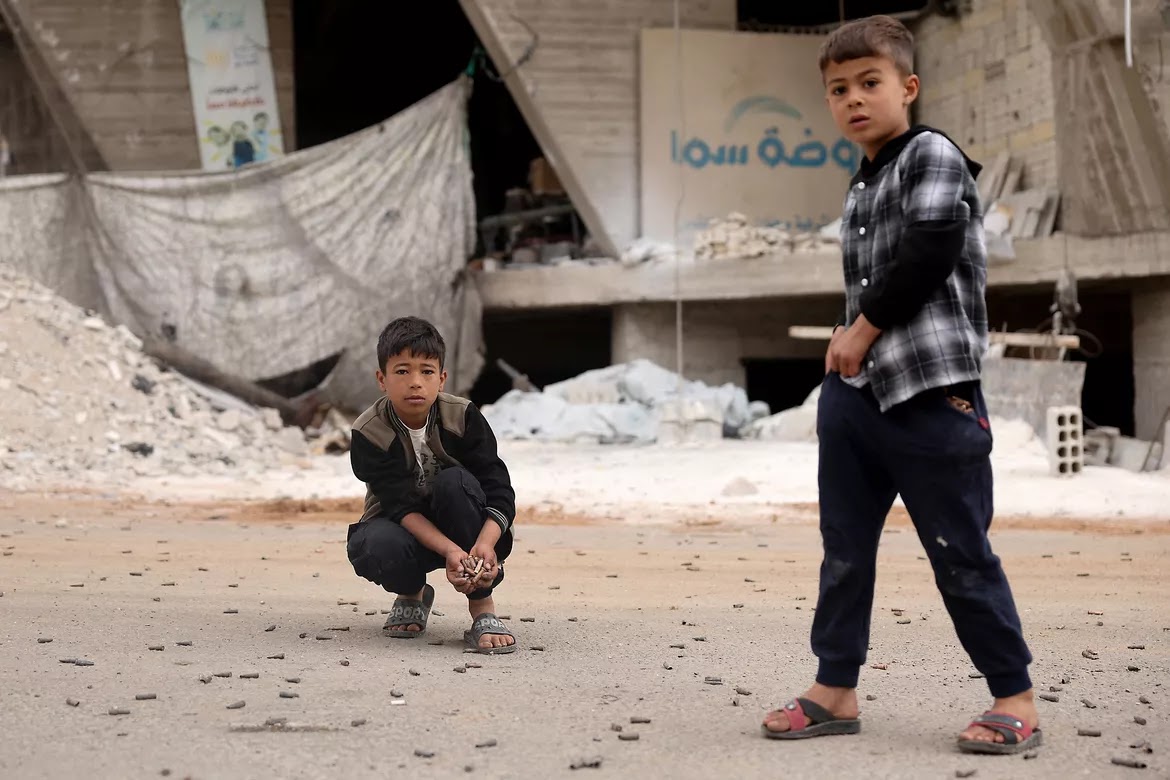Boys collect empty bullet casings on Thursday following sectarian clashes in Ashrafiyat Sahnaya, Syria, near Damascus. (Omar Haj KadourAFP)
More than 100 people were killed last week in a Druse minority-controlled area, and Druse leaders indicated a renewed desire to work with the government, which is dominated by Sunni Muslims.
As battles between pro-government forces and militants from Syria's Druse minority expanded to new locations, a war monitoring group reported on Thursday that the number of people killed in this week's outbreak of sectarian violence in Syria has topped 100.
However, in an attempt to quell the violence, government officials reached agreements with Druse leaders by Thursday evening. The action also seemed to be a step toward the new government's objective of creating a national military by combining the intricate network of armed organizations operating nationwide. Formerly hesitant to join forces with the government, leaders in the Druse-controlled Sweida region said they were open to the idea.
An audio clip allegedly showing a Druse priest disparaging the Prophet Muhammad went viral on social media on Tuesday, sparking the disturbance. Syria's Interior Ministry stated he was not engaged, and the cleric refuted the charge.
However, locations with sizable Druse populations, such as the town of Jaramana close to the capital, Damascus, were targeted by armed Sunni Muslim extremist organizations. The government dispatched troops to put an end to the disturbances after Druse militias reacted violently.
The fighting moved to Ashrafieh Sahnaya, another village on the southern suburbs of Damascus, on Wednesday. From there, it moved to Sweida, where it lasted until Thursday morning.
Five well-known Druse leaders issued a statement Thursday evening stating that judicial police and Interior Ministry staff "drawn from the people" of Sweida "must be activated," expressing a readiness to cooperate with the government.
They added that government troops were being sent in to guard the road that connects Sweida with the capital, where fighting broke out on Wednesday. According to Druse leaders there, the government reportedly consented to send more troops to guard Jaramana.
A group of Druse leaders from Sweida were attacked on their approach to Ashrafieh Sahnaya on Wednesday morning by Bedouin tribal fighters armed with mortars and machine guns, according to Jibran, a physician who provided medical care to some of the injured in Sweida.
According to Jibran, who asked to be identified only by his first name due to the ongoing threat of violence, Bedouin tribes that night started shelling a Druse militia checkpoint in the town of Kanaker, southwest of Sweida, igniting another battle overnight, even though government security forces later arrived to restore order. Approximately 70 individuals have been slain or reported missing, he said.
This week's significant outbreak of sectarian violence, the second since a rebel coalition overthrew President Bashar al-Assad and took control of the country, further revealed Syria's divisions in a place where minorities already felt extremely threatened.
The Islamist organization Hayat Tahrir al-Sham, which was formerly associated with Al Qaeda, commanded that coalition, which also comprised other Islamist armed groups with more radical beliefs. The new Syrian government has not been able to control many of those groups, and they have not disbanded into the country's new military.
By Thursday, the number of people killed after three days of fighting had risen to 101, according to the Syrian Observatory for Human Rights, a war monitor headquartered in Britain.
For the first time, the Observatory said Thursday that five Druse fighters had been slain in a Sweida village and 35 Druse had been killed on the route that connects Sweida to Damascus.
According to the Observatory, Hassan Warwar, a former local mayor, and his son were among those slain in Ashrafieh Sahnaya on Wednesday.
According to the Observatory, 10 ally organizations and 20 members of the government's security forces were also slain during this week's disturbances.
The religion practiced by the Druse is a branch of Islam. Israel, which has a tight ties with Israeli Druse, also joined the conflict on Wednesday, attacking Syrian Druse civilians with airstrikes against what it said as "operatives."
On Wednesday, thousands of fighters engaged in combat in various locations between Sweida and Daraa, another city in the southwest, according to Abu Hassan, a Druse militia commander in Sweida who uses a pseudonym. He claimed that among other things, Bedouin militants who were affiliated with the government were engaged in combat with Druse terrorists.
In a news conference on Wednesday, Amr al-Sheikh, the governor of the region that encompasses Jaramana and Ashrafieh Sahnaya, condemned "outlawed groups" for inciting the first violence, although he did not name the groups. Mr. al-Sheikh said that official government soldiers had been sent in to guard the two towns, but he did not admit the existence of armed groups that supported the government.
However, other security officials have privately admitted that the government cannot keep all armed groups under control.
Loubna Baset, a Druse activist in Sweida, stated, "We have the right to keep our weapons to protect ourselves from these random factions."
She went on to say, "We don't trust the government, even though they say they are sending all these military reinforcements to protect us."
The government's general security forces comprise combatants from the nation's Sunni Muslim majority as well as Druse and other minorities, notwithstanding the sectarian fighting lines. Among the general security forces murdered this week were Druse.
However, despite the government's assurances of tolerance, Syrian minorities are still on edge. This unease was heightened in March when a wave of sectarian killings struck Syria's coastline area, which is home to the Alawites, the minority group to which the Assad family belongs.













0 Comments